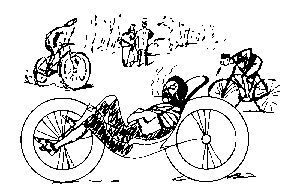Mayors' Ride |
NBG Biking Cities |
Podcasts | Bicycles: Recumbents,
Busycle,
HiWheelers, Velomobiles Movements: Car Free,
Trailer,
|
|
Why Ride Modified from what appeared in the 1987-94 Cycle America Regional Directories History of the Modern Day Recumbent Long Version |
|||||||
 Recumbent Bicycles have been around since even before the turn of the century. In fact, in 1892, this recumbent cartoon made its way around the world of print while in 1895, the recumbent you see pictured below made it's presence at a bicycle show in Geneva, Switzerland. Recumbent Bicycles have been around since even before the turn of the century. In fact, in 1892, this recumbent cartoon made its way around the world of print while in 1895, the recumbent you see pictured below made it's presence at a bicycle show in Geneva, Switzerland.
Also in 1977 Dick Ryan, of the deceased Ryan Recumbent (history) joined Dick Forrestal and Harold Maciejewski to begin manufacturing the Avatar designed by MIT profeesor and Bicycle Science author David Gordon Wilson. Returning to the West Coast, Smitty Smith, Milt Turner and Jack Baker unveiled the Hypercycle (the first Short Wheel Base recumbent and predecessor to the now defunct S&B Recumbents). Then when E.I. Dupont, the chemical giant, offered $15,000 to the first human powered single rider machine that could top 65 miles per hour, a new era in bicycling had been reborn. This was so because when the engineers went to work, it was the recumbent design, which is 25 to 33% more aerodynamically efficient than a conventional upright bicycle, that satisfied their equations for a two wheeler that could produce such speed.
Soon, in 1986, a recumbent bicycle built by Easy Racers and ridden by Fast Freddy Markham (podcast part ONE, part TWO) captured the Dupont prize. It was his victory that gave a shot of adrenaline to the fledgling industry that Wilson, Martin, Schlitter, Kyle, Lambie, Brummer, Ryan, Baker and countless others had helped to revitalize. Since then, scores of manufacturers and a myriad of different laid back machines have sprouted up all over the world. In 1990 Recumbent Cyclist News (archive) then, with great success, began helping these builders merchandise their wares to a very receptive public. Here now it is the world wide web that has catapulted the recumbent bicycle to an even higher level of popularity and excitement. And the renewed interest these bikes are enjoying is far more than just about speed. Besides the fact that recumbents also hold the one hour and 4000 meter pursuit records along with many other speed successes, comfort was rediscovered as an interesting by-product of the engineer's quest for speed. With the recumbent, people are discovering that their bicycle does not have to cause them pain. Not at all. in fact, they can be ridden for hours and miles without ailments such as the sore butt, stiff neck, aching shoulders or numb hands that afflict the conventional bicycle rider. Instead the recumbent rider experiences far greater comfort, a better view of the world, a toning and strengthening of the abdomen. even a better sun tanning position. And no, they are not dangerous. In fact the lower center of gravity and greater proximity to the ground mean that if you should crash on one, your feet will absorb most of the shock instead of your head. Because more of your weight is over the rear wheel, recumbents also stop faster. Cars see you better, too, because the biggest part of your body is in the car driver's field of vision and you do not blend in with pedestrians, joggers or conventional bicyclists. Comparing my two bike rides across the US, the recumbent position proved infinitely superior. I could enjoy my time off of the bike and still had energy at the end of a day for more than just climbing into my sleeping bag or looking for a hotel room. I also enjoy the added respect that motorists give me and the inquisitive people I meet even today. If you're interested in learning more about recumbents, here are some Sources. When you add one to your bicycle fleet you'll understand why man does not live by one bike alone! Martin Krieg |
|||||||
|
|
Copyright 2021 National Bicycle Greenway - We value your privacy. Please check our privacy
policy.
National Bicycle Greenway, Indianapolis & San Francisco 415-900-6861 NBG@BikeRoute.com